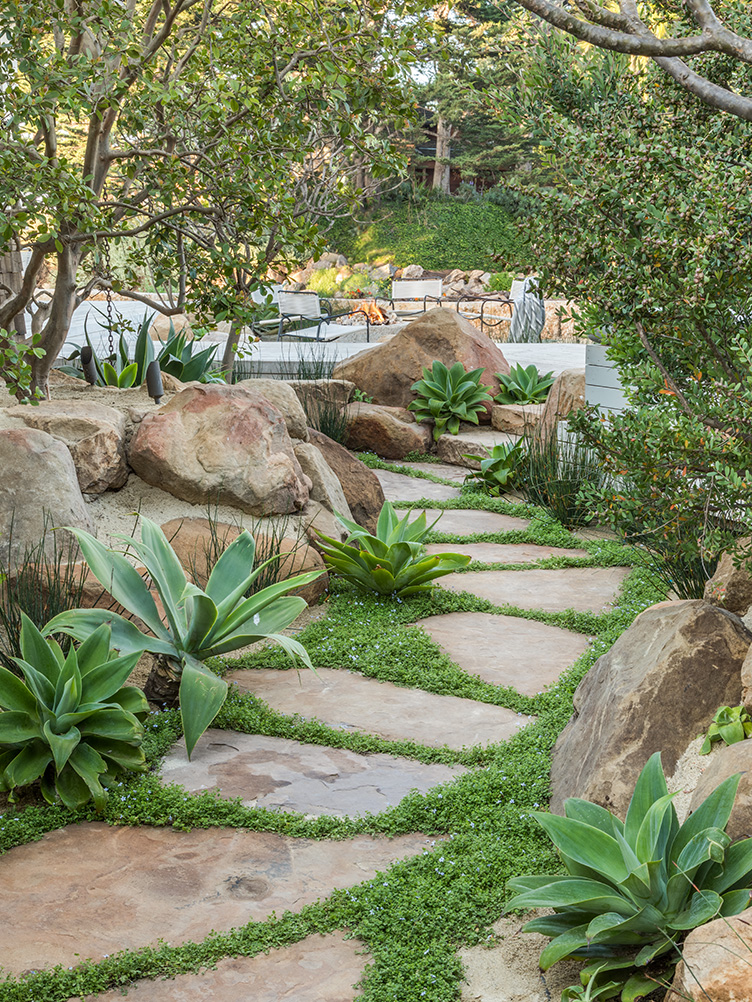For landscape architect Scott Shrader, the relationship between the interior and exterior of a home is an intimate one. His gardens look and function like natural extensions of the living space—lush landscapes constantly beckoning you to move the party outdoors. Some of Hollywood’s most notoriously design-obsessed celebs, Ellen DeGeneres, Portia de Rossi, and Patrick Dempsey among them, have turned to him for his prowess with plants and landscape design. His first book, The Art of Outdoor Living: Gardens for Entertaining Family and Friends, released this spring by Rizzoli, features thirteen of his incredible gardens, each underpinned by his sustainability-focused approach. Here, Scott gives us a guided tour through one of the gardens featured in the book, and shares some of his tips for a garden that grows, and flows, beautifully.


The Property
“To be here is to want to interact with the water, air, and views, day and night, from all points on the property,” says Scott of his Rincon Point garden project, located along California’s rugged northern coast. “To make that possible we used materials that bring the feeling of the shore right up to the threshold of the house and visually extend the experience of the living spaces to the beach and water beyond.” Outdoor decking in a similar tone to the wood floors inside makes the transition from indoors to out pratically seamless.


The Story
“I developed a story of a tsunami landing on the house,” says Scott of his overall vision for the garden’s design. “When it passed, it left the house engulfed in an almost accidental landscape of randomly scattered boulders (in a practical touch, these serve as impromptu seating), drifts of sand, and an assemblage of boardwalks that tie the house and gardens together.” Agaves randomly nestled between these large boulders seem wholly unplanned, and outdoor furnishings made of rusty metals, well-worn woods and stone all but disappear amongst the boulders.


The Functionality
Far from being purely ornamental, Scott thoughtfully designed this exterior landscape to be in constant use. “Beyond the walls, we casually integrated layers of function with environments conducive to lounging, casual dining, conversation, and just hanging out—a fire pit; an easy area for four to six to share a meal, play cards, or shuck oysters; a larger lounge area for bigger groups; plus, of course, the numerous boulders that offer incidental places to sit or put down a drink.”


The Plantings
“This house offered the perfect opportunity for a boardwalk garden, a first for me,” says Scott. “We knew the plant palette had to consist of drought-tolerant salt-lovers native to California.” An arbor of fig trees was added outside the master bedroom window, as well as a strawberry guava to commemorate the birth of the homeowner’s first granddaughter. “With four large trees—including a spectacular, mature Monterey cypress—still standing proud, we began to shape our vision with the understory, arranging Metrosideros to grow into a hand-clipped screen around the property’s perimeter,” says Scott. In addition, fifteen Monterey cypress trees were added, with the intention that they’ll someday mature into more monumental canopies of green.

Scott’s 7 Tips For A Gorgeous Garden
1. Approach Plants Like a Party
“When beginning the daunting task of creating a plant palette for a garden, think of plants as friends you’re inviting to a party. Some like to drink, some don’t. Some love the sun, others prefer shade. Some love to eat and need constant nourishment, others don’t. Some love to talk and tend to take over and be a bit invasive, while others prefer to be quiet and blend well with others. Personalizing plants and their general needs often helps simplify this initial process when creating a garden.”
2. Give Your Garden A Ceiling
“People often feel most comfortable when they have some kind of covering overhead, such as an umbrella, trellis or specimen tree. These outdoor ceilings provide a sense of shelter and shade. Also, these ceilings are useful for lighting. Hiding lights within a trellis or a formation of trees can be really helpful with illuminating the garden in the evening for entertaining.”
3. Get Wormy With It
“Worm castings are my go-to organic fertilizer. I often mix the castings into my potting and planting mixes. For my container plants, I find a 1” top layer of worm castings help to create a powerfully organic tea that saturates the soil each time you water.”
4. Make A Small Space…Smaller!
“When you have a small space, think about dividing it up into several even smaller spaces. This process can prove helpful for enhancing the mood, character, and uniqueness of a garden. Sometimes it is not best to give it all away at one time. Instead, allow people to be surprised by encouraging them to experience a garden through divided rooms.”
5. Embrace Garden Geometry
“Simplicity is enormously powerful. I love using basic, essential geometric shapes like squares and rectangles to frame the different areas of the garden. This not only helps to ground each space without distracting from the views, but also plays an important role in establishing an easy, organic sense of flow.”
6. Don’t Forget What’s Underfoot
“To help create a seamless flow inside to out, I pay particular attention to the interior floors of a home. As one physically and visually transitions from inside to out, the blending of materials is most important. Think about the color, tone and material so as not to distract one’s attention or create the need to look down. The idea is to keep people’s eyes looking forward and taking in beauty, not worrying about navigating a difficult transition.”
7. Develop A Multi-Year Plan
“Gardens are all about change, so it’s key to plan for the future. Knowing how tall the trees grow and how all the shrubs will mature and fill in is essential in creating a beautiful garden that can mature well over time.”
Shop Outdoor Furniture Essentials >>
Lead Photo by Lisa Romerein, Courtesy of The Art of Outdoor Living (Rizzoli)
































